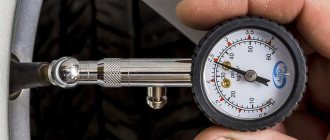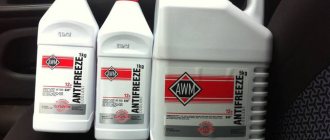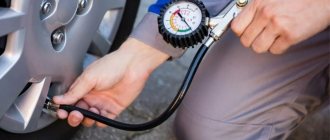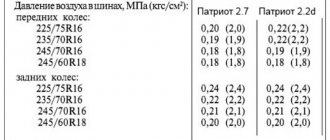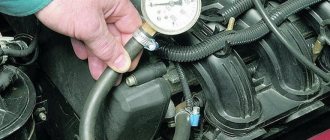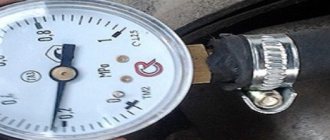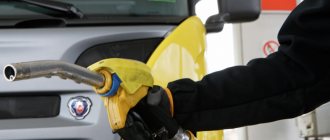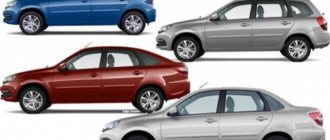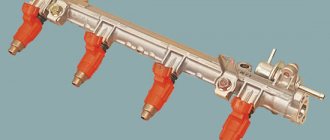Pressure is an important physical quantity often used in automotive technology. Here are the simplest cases, for example, the well-known requirements for tire pressure and more hidden ones, fuel pressure, engine and transmission oils, numerous hydraulic components. In specifying and measuring numerical values, a system of units will be required, which differs in the technical traditions of different countries and schools.
Correlation and conversion of quantities
The need to convert units of measurement from different metric systems is in demand in production. Equipment supplied by manufacturers, especially foreign ones, is often equipped with control devices with unusual calibration. To quickly make a translation, you need to know that:
- The difference between technical and standard atmospheres is small (1 atm = 1.033 atm), so it is neglected in practical calculations.
- One megapascal is equal to 10.1972 kgf/cm² or 9.8692 atm.
- The technical atmosphere in MPa for technical calculations is considered equal to 0.1, and the physical atmosphere is 0.987.
- 1 mm water Art. with sufficient accuracy can be taken equal to 10 Pa, for mercury 133 Pa.
- Using the specified values in calculations gives an error of 0.5%. A result with an error of 2% is obtained if the initial data is based on the calculation of 1 MPa = 10 at. The ratio 1 MPa = 10 atm is taken when an error of 3% is permissible when converting atmospheric pressure.
To convert megapascals to atmospheres, coefficients are used by which the original value is divided. To get the result in atm 0.101972, for atm 0.098692.
To find out how many technical atmospheres contain 12 MPa, you need to enter 12/0.101972 into the search bar, for example in Yandex. After instant calculation, the result will be 117.679362962.
Measuring instruments
The main devices for checking tire pressure are mechanical or digital pressure gauges, which come in several types:
- gear with scale and pointer;
- rack and pinion with cylindrical spring;
- electronic with information board.
Mechanical models are practical and reliable. They are often supplemented with a built-in mechanism for releasing excess air and a deflator on a flexible hose for easy inflation. Rack and pinion modifications are distinguished by accuracy, compactness, and ease of use. Electronic tire pressure gauges are modern devices with sensitive sensors and the ability to be customized to the user’s needs, including units of measurement.
Important! Tire pressure measurements should be carried out on a car that has stood motionless for at least 10-20 minutes (optimally 7-8 hours) and the heated air inside the wheels has had time to cool and compress to its natural state.
Pascal
How to convert psi pressure into atmospheres
So, pascal (Pa) is a measure of pressure, mechanical stress, elastic modulus and some other characteristics used in technology. A pressure of 1 pascal is created by a force of 1 newton, uniformly distributed over an area of 1 square meter perpendicular to the direction of its action (1 Pa = 1 N/m2). Remembering that 1 N = 1 kg∙m/s 2, we can express the pascal in terms of SI base units: 1 Pa = 1 kg/(m∙s 2).
Pressure is a scalar quantity; it characterizes the result of the action of an external force on a surface distributed over its area. Let's explain this with an example: imagine a person who first moves through loose snow on skis, and then takes them off and falls deep into a snowdrift. In the first case, the force - the weight of a person - is evenly distributed over a relatively large surface of the skis, in the other - only over the area of the foot, which leads to an increase in pressure, and consequently to subsidence of the snow.
External forces acting on a body tend to shift the position of the particles of which it consists. In response to this, internal forces will arise within the body that prevent displacement. The measure of the result of their action is called mechanical stress, which is also expressed in pascals.
Table for converting PSI pressure to bar (atmospheres)
The above coefficient of 14 is an average. If we go into scrupulous detail, the meaning for converting PSI into atmospheres is somewhat different. It will be easier to refer to the table below to find out the information:
| Atm (Atmospheres) | PSI |
| 1,4 | 20 |
| 1,5 | 22 |
| 1,6 | 23 |
| 1,7 | 25 |
| 1,8 | 26 |
| 1,9 | 28 |
| 2 | 29 |
| 2,1 | 30 |
| 2,2 | 32 |
| 2,3 | 33 |
| 2,4 | 35 |
| 2,5 | 36 |
| 2,6 | 38 |
| 2,7 | 39 |
| 2,8 | 41 |
| 2,9 | 42 |
| 3 | 44 |
( 15 votes, average: 4.80 out of 5)
What color car is better to choose?
How and with what to lubricate car door hinges
Related Posts
Normal atmospheric pressure for humans
Psi in atmosphere
Normal atmospheric pressure is 760 mmHg or 101,325 Pa at 0℃ at sea level (45º latitude). At the same time, the atmosphere acts on every square centimeter of the earth's surface with a force of 1.033 kg. A column of mercury 760 mm high balances the mass of this air column.
The figure of 760 mm was also determined by Torricelli during the experiment. He also noticed that when a flask is filled with mercury, there is a void at the top. Subsequently, this phenomenon was called the “Torricelli void.” Then the scientist did not yet know that during his experiment he created a vacuum - that is, a space free from any substances.
At a standard pressure of 760 mmHg a person feels most comfortable. If we take into account the previous data, then the air presses on a person with a force of about 16 tons. Why then do we not feel this pressure?
The fact is that there is also pressure inside the body. Not only people, but also representatives of the animal world have adapted to atmospheric pressure. Each organ was formed and developed under the influence of this force. When the atmosphere acts on a body, this force is distributed evenly over the entire surface. Thus, the pressure is balanced and we do not feel it.
Atmospheric pressure map of Russia
The atmospheric pressure norm should not be confused with the climate norm. Each region has its own standards for a certain time of year. For example, residents of Vladivostok are lucky, since the average annual atmospheric pressure there is almost equal to the norm - 761 mm Hg.
And in settlements located in mountainous areas (for example, in Tibet), the pressure is much lower - 413 mm Hg. This is due to the altitude of about 5000 m.
Hydrostatic pressure
Hydrostatic pressure is the pressure of a fluid caused by gravity. This phenomenon plays a huge role not only in technology and physics, but also in medicine. For example, blood pressure is the hydrostatic pressure of blood on the walls of blood vessels. Blood pressure is the pressure in the arteries. It is represented by two values: systolic, or the highest pressure, and diastolic, or the lowest pressure during a heartbeat. Devices for measuring blood pressure are called sphygmomanometers or tonometers. The unit of blood pressure is millimeters of mercury.
Digital blood pressure machine, also called a sphygmomanometer
The Pythagorean mug is an interesting vessel that uses hydrostatic pressure, specifically the siphon principle. According to legend, Pythagoras invented this cup to control the amount of wine he drank. According to other sources, this cup was supposed to control the amount of water drunk during a drought. Inside the mug there is a curved U-shaped tube hidden under the dome. One end of the tube is longer and ends in a hole in the stem of the mug. The other, shorter end is connected by a hole to the inside bottom of the mug so that the water in the cup fills the tube. The principle of operation of the mug is similar to the operation of a modern toilet cistern. If the liquid level rises above the level of the tube, the liquid flows into the second half of the tube and flows out due to hydrostatic pressure. If the level, on the contrary, is lower, then you can safely use the mug.
How to use an online calculator?
Pressure in a coffee maker: how much bar should it be
Description of the calculator functionality
- Left column of the calculator. Contains a selection of initial values. A precise technical description of the quantity is displayed below each column.
- Right column of the calculator. Contains the final translation value. Under each column there is a detailed description of the final transfer amount.
- Getting results. To convert MPa to pascals, enter the values of the original value. The online calculator will quickly translate the original data.
To convert extremely large and small numbers, a separate concept is used: computer exponential notation. Using this method, it is possible to write numbers with high concomitant abbreviations.
Who is the online calculator designed for?
- For specialists who conduct scientific research. You can easily convert, for example, a bar to a torr.
- For vehicle owners. Very often it is necessary, for example, to convert MPa to bars. This data is used to analyze the condition of the fuel line, as well as to check the nominal tire pressure of the vehicle.
- Car owners use a calculator when converting a single value into MPa in the process of filling car parts with freon.
Getting to know PSI
Now we should talk about what kind of unit of measurement PSI is.
In relation to tires, PSI can also often mean pressure. This unit of measurement is widely used in the USA and other countries where the inch system of measurements is used.
If you ask a person who lives according to the inch (English) system what the atmosphere in tires means, he will answer approximately the same as our person about PSI. Surely nothing at all, since such units, which are familiar to us, are not used there. This means there is no need to worry about this. We'll fix everything.
When dealing with the issue of PSI, it is important to note the following.
1 PSI unit corresponds to 51.715 mm. mercury column. This is approximately 14 times less than in the case of the atmosphere. Measured in pounds per square inch.
And it is quite natural to ask how much PSI should be to create the correct pressure in the tires of any car where other units of measurement are used.
In the case of domestic motorists, there is a need to convert one unit to another. This will go a long way toward understanding how much PSI your car's tires should actually have.
Story
It was originally defined as a pressure exerted by 760 mmHg. Art. At 0 °C and standard gravity ( g
n =9.806 65 m/s 2 ).
It was used as a reference condition for physical and chemical properties and was implied in the definition of the Celsius (later Celsius) temperature scale, defining 100 °C as the boiling point of water at that pressure. In 1954, the 10th General Conference on Weights and Measures (CGPM) adopted a standard atmosphere
for general use and confirmed its definition: 1,013,250 dynes per square centimeter (101,325 Pa). This determined both temperature and pressure, regardless of the properties of a particular substance. In addition (noted by the CGPM) there was some misconception that this "has led some physicists to believe that this definition of a standard atmosphere is valid only for precise work in thermometry."
In chemistry and various industries, the reference pressure specified in "standard temperature and pressure" (STP) was usually 1 atm (101.325 kPa), but standards have diverged since then; in 1982, the International Union of Pure and Applied Chemistry (IUPAC) recommended that, for the purpose of determining the physical properties of substances, " standard pressure
"was exactly 100 kPa (1 bar).
General information about pascals
A quantity such as pascal is used to measure atmospheric force, the action of which extends strictly perpendicularly to a unit surface. A force of one newton over an area of one square meter is equal to one pascal. These numbers indicate a fairly low atmospheric pressure, so the resulting measurements are reported in megapascals (MPa) or kilopascals (kPa).
Atmospheric pressure in different fields of activity is measured in different quantities. For example, when measuring it in cars, the following values may be indicated:
- atmosphere,
- bars,
- pounds per square inch,
- megapascals,
- kilogram of force per square centimeter - technical atmosphere.
Pascal belongs to the International System of Units (SI) and is also used to measure elastic moduli, yield strength, mechanical stress, fugacity, proportionality limit, osmotic and sound pressure, tensile and shear strength, Young's modulus.
The dimensions of the units of measurement of this quantity and energy are the same, but they describe different physical properties of objects, and therefore cannot be considered equivalent. Therefore, pascals are not used as a unit of energy density, and pressure is not measured in joules.
The general rules of the International System of Units establish that the name of the pascal unit is written with a lowercase letter, and its designation with a capital letter. This rule holds true when writing other units of measurement formed using pascal. This quantity first became known in France in 1961 thanks to the mathematician and physicist Blaise Pascal, after whom it was named.
Megapascals
Megapascal is a unit of measurement of the atmospheric column that is a multiple of pascal. In order to convert megapascals into atmospheres, special calculators are most often used, many of which work online.
One megapascal is one thousand kilopascals, which in turn is one million pascals. How many atmospheres are then contained in a megapascal? If we accurately translate these values, then one megapascal is 10.197 atm and 9.8692 atm - technical and physical atmospheres, respectively.
When solving physical problems, accurate calculations are rarely carried out, therefore the standard 1 atmosphere in megapascals is taken as 0.1 MPa, and the physical one as 0.987 MPa (when calculated back, 1 MPa is 10 technical atmospheres and 9.87 physical). At the same time, one millimeter of water column is equal to about 10 Pa, and one mercury column is 133 Pa. The normal value - 760 millimeters of mercury - is equal to 101,325 pascals or 101 kilopascals.
Hydrostatic pressure
Hydrostatic pressure is the pressure of a fluid caused by gravity. This phenomenon plays a huge role not only in technology and physics, but also in medicine. For example, blood pressure is the hydrostatic pressure of blood on the walls of blood vessels. Blood pressure is the pressure in the arteries. It is represented by two values: systolic, or the highest pressure, and diastolic, or the lowest pressure during a heartbeat. Devices for measuring blood pressure are called sphygmomanometers or tonometers. The unit of blood pressure is millimeters of mercury.
The Pythagorean mug is an interesting vessel that uses hydrostatic pressure, specifically the siphon principle. According to legend, Pythagoras invented this cup to control the amount of wine he drank. According to other sources, this cup was supposed to control the amount of water drunk during a drought. Inside the mug there is a curved U-shaped tube hidden under the dome. One end of the tube is longer and ends in a hole in the stem of the mug. The other, shorter end is connected by a hole to the inside bottom of the mug so that the water in the cup fills the tube. The principle of operation of the mug is similar to the operation of a modern toilet cistern. If the liquid level rises above the level of the tube, the liquid flows into the second half of the tube and flows out due to hydrostatic pressure. If the level, on the contrary, is lower, then you can safely use the mug.
Why do you need a pressure unit conversion calculator?
The online calculator will allow you to quickly and accurately convert values from one pressure measurement unit to another. This conversion can be useful to car owners when measuring engine compression, checking the pressure in the fuel line, inflating tires to the required value (very often you have to convert PSI to atmospheres or MPa to bar when checking pressure), and filling the air conditioner with freon. Since the scale on the pressure gauge may be in one number system, and in the instructions in a completely different one, there is often a need to convert bars into kilograms, megapascals, kilograms of force per square centimeter, technical or physical atmospheres. Or, if you need a result in the English numeral system, then pound-force per square inch (lbf•in²), in order to exactly correspond to the required instructions.
Nuances of translation in different units
On the body of many “pure Europeans” the value in psi is already indicated, which the manufacturer targets. For cars of foreign brands that are assembled on our territory, the technical atmosphere indicator applies. So, the approximate ratio will be as follows:
1 Atmosphere contains 14 PSI.
Confusion may arise if the tire or compressor (by the way, which one is better to choose, read here) shows the acceptable values in the BAR. In fact, 1 Bar is approximately equal to 1 atmosphere, so you can use this ratio. For those. For those who are interested in how this all turned out mathematically, here is a simple proof:
- 1 pound contains approximately 0.453 kilograms;
- at the same time, in every square inch there are 6.4516 square centimeters.
We find that one PSI will contain 0.07 kg/cm2, or in each atmosphere, on the contrary, there will be approximately 14 PSI. Despite the fact that such designations may not be entirely familiar to a Russian driver, translation is usually not difficult. The need may arise when purchasing car tires or devices for inflating air. At the same time, Chinese manufacturers often indicate several designations in their products for convenience.
Watch water resistance standards
There are many different standards that determine the water resistance of watches and other electronic devices (such as phones). Waterproof watches are very popular among tourists, climbers and extreme sports enthusiasts.
Watch water resistance standard ISO 2281 (GOST 29330)
This standard was adopted in 1990 to standardize the water resistance of watches. It describes the procedure for checking the water resistance of a watch during testing. The standard specifies the requirements for water or air pressure at which the watch must maintain its tightness and performance. However, the standard states that it can be carried out selectively. This means that not all watches produced according to this standard undergo mandatory water resistance testing - the manufacturer can selectively check individual pieces. This standard is used for watches that are not specifically designed for diving or swimming, but only for watches for daily use with possible short-term immersion in water.
Testing a watch to this water resistance standard consists of the following steps:
- Immerse the watch in water to a depth of 10 cm for one hour.
- Immerse the watch in water to a depth of 10 cm with a water pressure of 5 N (newtons) perpendicular to the buttons or to the crown for 10 minutes.
- Immerse the watch in water to a depth of 10 cm and change the temperature between 40°C, 20°C and again 40°C. The watch stays at each temperature for five minutes, the transition between temperatures is no more than five minutes.
- Immersion of watches in water in a pressure chamber and exposure of them to their nominal pressure for which they are designed for 1 hour. Condensation inside the watch and water penetration into the case are not allowed.
- Checking the watch with 2 atm above the rated pressure.
Well, additional checks not directly related to the water resistance of the watch:
- The watch must not show streamlining exceeding 50 μg/min
- No strap test required
- No corrosion test required
- No negative pressure test required
- No magnetic field or shock test required
ISO 6425 standard - diving and diving watches
This standard was developed and adopted in 1996, and is intended specifically for watches that have increased requirements for water resistance, such as watches for diving, spearfishing and other types of underwater work.
All watches manufactured according to ISO 6425 are required to be tested for water resistance. That is, unlike the ISO 2281 standard, where only individual watches are tested for water resistance, in the ISO 6425 standard, absolutely all watches are tested at the factory before sale.
Moreover, the check is also carried out in excess of the calculated indicators by 25%. That is, a watch designed for diving up to 100 meters will be tested at the same pressure as at a depth of 125 meters.
According to the ISO 6425 standard, all watches must pass the following water resistance tests: Prolonged exposure to water. The watch is immersed in water to a depth of 30 cm for 50 hours. Water temperature can vary from 18°C to 25°C. All mechanisms must continue to function, and no condensation should appear inside the watch. Check for condensation in the watch. The watch heats up to a temperature of 40°C - 45°C. After this, cold water is poured onto the watch glass for 1 minute. Watches that develop condensation on the glass on the inside surface of the glass should be destroyed. Resistance of crowns and pushers to increased water pressure. The watch is placed in water and pressurized in water 25% above its water resistance rating. Within 10 minutes in such conditions, the watch should remain sealed. Long-term exposure to water under pressure exceeding the design pressure by 25% for two hours. The watch must continue to work and remain sealed. Condensation should not form on the glass.
Immersion in water to a depth of 30 cm, changing the water temperature from 40°C to 5°C and again 40°C. The transition time from one dive to another should not exceed 1 minute.
Exceeding the design pressure by 25% provides a safety margin to prevent getting wet when there is a dynamic increase in pressure or a change in water density, for example, sea water is 2 - 5% denser than fresh water.
Watches that have passed ISO 6425 testing are marked with the inscription DIVER'S WATCH L M. The letter L indicates the immersion depth in meters guaranteed by the manufacturer.
Pressure in geology
Quartz crystal illuminated by laser pointer
Pressure is an important concept in geology. Without pressure, the formation of gemstones, both natural and artificial, is impossible. High pressure and high temperature are also necessary for the formation of oil from the remains of plants and animals. Unlike gems, which primarily form in rocks, oil forms at the bottom of rivers, lakes, or seas. Over time, more and more sand accumulates over these remains. The weight of water and sand presses on the remains of animal and plant organisms. Over time, this organic material sinks deeper and deeper into the earth, reaching several kilometers below the earth's surface. The temperature increases by 25 °C for every kilometer below the earth's surface, so at a depth of several kilometers the temperature reaches 50–80 °C. Depending on the temperature and temperature difference in the formation environment, natural gas may form instead of oil.
Diamond tools
Natural gemstones
The formation of gemstones is not always the same, but pressure is one of the main components of the process. For example, diamonds are formed in the Earth's mantle, under conditions of high pressure and high temperature. During volcanic eruptions, diamonds move to the upper layers of the Earth's surface thanks to magma. Some diamonds fall to Earth from meteorites, and scientists believe they formed on planets similar to Earth.
Synthetic gemstones
The production of synthetic gemstones began in the 1950s and has been gaining popularity recently. Some buyers prefer natural gemstones, but artificial stones are becoming more and more popular due to their low price and lack of hassles associated with mining natural gemstones. Thus, many buyers choose synthetic gemstones because their extraction and sale is not associated with human rights violations, child labor and the financing of wars and armed conflicts.
One of the technologies for growing diamonds in laboratory conditions is the method of growing crystals at high pressure and high temperature. In special devices, carbon is heated to 1000 °C and subjected to pressure of about 5 gigapascals. Typically, a small diamond is used as the seed crystal, and graphite is used for the carbon base. From it a new diamond grows. This is the most common method of growing diamonds, especially as gemstones, due to its low cost. The properties of diamonds grown in this way are the same or better than those of natural stones. The quality of synthetic diamonds depends on the method used to grow them. Compared to natural diamonds, which are often clear, most man-made diamonds are colored.
Due to their hardness, diamonds are widely used in manufacturing. In addition, their high thermal conductivity, optical properties and resistance to alkalis and acids are valued. Cutting tools are often coated with diamond dust, which is also used in abrasives and materials. Most of the diamonds in production are of artificial origin due to the low price and because the demand for such diamonds exceeds the ability to mine them in nature.
Some companies offer services for creating memorial diamonds from the ashes of the deceased. To do this, after cremation, the ashes are refined until carbon is obtained, and then a diamond is grown from it. Manufacturers advertise these diamonds as mementos of the departed, and their services are popular, especially in countries with large percentages of wealthy citizens, such as the United States and Japan.
Pressure units
There are several basic options for the units in which tire pressure can be measured.
This is about:
- atmospheres (atm);
- barah (bar);
- pascals (Pa);
- PSI.
One wheel, and so many options for measuring pressure in it.
Motorists are accustomed to the pressure specified in atmospheres or bars being prescribed in technical documentation. It is this that should be maintained in the wheels during vehicle operation, since this is how the automaker calculated that the car will operate in optimal conditions. That is, a better balance between stability, fuel consumption, grip, acceleration and braking dynamics.
In this case, it is allowed for the wheels on different axles to have different pressures. For example, when the trunk is heavily loaded, then the rear wheels can be inflated 0.1-0.2 atm more than the front ones.
It is important to understand the units of measurement and understand how they differ from each other and whether one unit can be converted to another
About heating boilers
To be honest, I started all this reasoning for the sake of a heating boiler; it is in modern models that require pressure in their system that have indicators on the side or on a digital display.
“Why is it needed?” - you ask. YES, it’s all simple guys, in modern boilers there is a pump that pushes water through the system, and the greater the pressure, the easier it is for it to do this! That is why if it drops to a minimum level (usually below 0.9 BAR), the boiler automatically turns off and will not work.
That is, in order for it to function normally, it needs to monitor the “bars”. However, it’s also not worth “borscht” - if you increase the pressure above 2.7 BAR, the boiler will also turn off (the protection will work), because the heat exchangers are made of copper or brass - and this is a soft material, it can simply break! Therefore, excess pressure relief systems have been installed.
That is why it is mandatory to bring out a sensor with an indicator.
Wow, this was a great article, I tried to cover the topic as much as possible. I think it worked.
Pascal (unit)
Pascal is equal to the pressure (mechanical stress) caused by a force equal to one newton, uniformly distributed over a surface normal to it with an area of one square meter.
1 Pa = 1 N/m 2 ≡ 1 J/m 3 ≡ 1 kg/(m s 2)
;
Comparison with other pressure units
In practice, approximate values are used: 1 atm = 0.1 MPa and 1 MPa = 10 atm. 1 mm of water column is approximately equal to 10 Pa, 1 mm of mercury is approximately equal to 133 Pa.
Normal atmospheric pressure is considered to be 760 mmHg, or 101,325 Pa (101 kPa).
The dimension of the pressure unit (N/m 2 ) coincides with the dimension of the energy density unit (J/m 3 ), but from the point of view of physics, these units are not equivalent, since they describe different physical properties. In this regard, it is incorrect to use Pascals to measure energy density, and write pressure as J/m 3.
- After adding footnotes, provide more precise indications of sources.
- Find and arrange in the form of footnotes links to authoritative sources that confirm what is written.
Wikimedia Foundation. 2010.
See what “Pascal (unit of measurement)” is in other dictionaries:
Pascal (unit) — Pascal (symbol: Pa, Pa) is a unit of pressure (mechanical stress) in SI. Pascal is equal to the pressure (mechanical stress) caused by a force equal to one newton, uniformly distributed over a surface normal to it... ... Wikipedia
Pascal (SI unit) - Pascal (symbol: Pa, Pa) is a unit of pressure (mechanical stress) in SI. Pascal is equal to the pressure (mechanical stress) caused by a force equal to one newton, uniformly distributed over a surface normal to it... ... Wikipedia
Pascal (pressure unit) - Pascal (symbol: Pa, Pa) is a unit of measurement of pressure (mechanical stress) in SI. Pascal is equal to the pressure (mechanical stress) caused by a force equal to one newton, uniformly distributed over a surface normal to it... ... Wikipedia
Unit of measurement Siemens - Siemens (symbol: cm, S) unit of measurement of electrical conductivity in the SI system, the reciprocal of ohm. Before World War II (in the USSR until the 1960s), siemens was the name given to the unit of electrical resistance corresponding to the resistance ... Wikipedia
Sievert (unit of measurement) - Sievert (symbol: Sv, Sv) a unit of measurement of effective and equivalent doses of ionizing radiation in the International System of Units (SI), used since 1979. 1 sievert is the amount of energy absorbed by a kilogram... ... Wikipedia
Becquerel (unit of measurement) - This term has other meanings, see Becquerel. Becquerel (symbol: Bq, Bq) is a unit of measurement of the activity of a radioactive source in the International System of Units (SI). One becquerel is defined as the activity of the source, in ... ... Wikipedia
Newton (unit of measurement) - This term has other meanings, see Newton. Newton (symbol: N) is a unit of force in the International System of Units (SI). The accepted international name is newton (designation: N). Newton derived unit. Based on the second... ...Wikipedia
Siemens (unit of measurement) - This term has other meanings, see Siemens. Siemens (Russian designation: Sm; international designation: S) a unit of measurement of electrical conductivity in the International System of Units (SI), the reciprocal of the ohm. Through others... ...Wikipedia
Tesla (unit of measurement) - This term has other meanings, see Tesla. Tesla (Russian designation: T; international designation: T) a unit of measurement of magnetic field induction in the International System of Units (SI), numerically equal to the induction of such ... ... Wikipedia
Gray (unit of measurement) - This term has other meanings, see Gray. Gray (symbol: Gr, Gy) is a unit of measurement of the absorbed dose of ionizing radiation in the International System of Units (SI). The absorbed dose is equal to one gray if the result is... ... Wikipedia
A little about atmospheres
As already mentioned, in most cases the pressure unit is the atmosphere. But not everyone understands what it even means.
The atmosphere is called pressure, which is equal to 1 kilogram per cm2. This is about 0.1 MPa (megaPascal).
In relation to the atmosphere, there are 2 standards:
- Technical. Denoted as at or at. In the technical case, 1 atm corresponds to 735.56 mmHg.
- Physical. This is already atm or atm. The difference is small since it is 760 mmHg.
In relation to the pressure in the wheels of a car, it is customary to equate the technical and physical atmosphere.
Do not forget that the difference between 1 atm and 1 bar is also insignificant. The latter corresponds to 750.06 mm. mercury column. Because of this, 1 atm = 1 bar. For motorists, the slight error between two units of pressure measurement is not taken into account. This will not affect the condition of the tire in any way.
How can weather-dependent people protect themselves from pressure changes?
The mercury pressure (the normal value can suddenly change to high or low several times during the day) cannot be adjusted, therefore
People dependent on weather conditions are advised to adhere to the following rules:
- get examined by a specialist. An examination by a doctor will reveal additional reasons for the body’s sensitivity to changes in atmospheric pressure (hidden chronic pathologies, hormonal imbalance or general weakening of the immune system);
- undergo treatment. Timely stop the exacerbation of chronic diseases under the supervision of a specialist;
- tracking weather forecasts or purchasing a home barometer. This method will allow you to prepare in advance for upcoming changes in atmospheric pressure and take preventive measures;
- ensure a good night's rest. The duration of night sleep should be at least 8 hours. It is also recommended to get up no later than 7 a.m. and go to bed before 10 a.m. Adequate sleep will allow the body to fully recover and more easily tolerate a decrease/increase in blood pressure;
- maintain a proper diet. Food should be varied and contain sufficient amounts of vitamins and minerals. Adequate nutrition will strengthen your immune system and make you less susceptible to fluctuations in atmospheric pressure. You should also exclude heavy and unhealthy foods from the menu, do not overeat before bed and do not allow long breaks between meals. This will avoid the development of pathologies in the gastrointestinal tract or exacerbation of chronic diseases that contribute to a decrease in immunity;
- Take daily walks in the fresh air (in any weather). Fresh air normalizes metabolic processes in the body, increases the amount of oxygen in the blood and helps strengthen the immune system;
- perform daily physical activity. If you have diseases that limit physical activity, a set of exercises is compiled in a physical therapy room under the supervision of a specialist. Exercises allow you to normalize the activity of the cardiovascular system, activate blood circulation and the functioning of joints. As a result, symptoms from fluctuations in atmospheric pressure will be less pronounced;
- adjust your daily routine. If possible, then during the period of the cyclone or anticyclone, postpone physical and mental work and devote more time to rest;
- take a contrast shower in the morning. The procedure allows you to normalize the condition of blood vessels, activates metabolic processes and strengthens the immune system;
- use vitamin complexes and immunomodulators. These drugs can further enhance the body’s defenses. The products are especially recommended for busy people who do not have the opportunity to take daily walks, exercise and other methods to strengthen the immune system;
- to refuse from bad habits. Nicotine and alcohol have a negative effect on blood vessels, gastrointestinal tract organs and aggravate the deterioration of the condition during changes in atmospheric pressure;
- taking medications. If you have chronic diseases, prepare the necessary medications (ointments for joint pain, tablets for headaches, or medications to lower/increase blood pressure). The type of drugs depends on the type of disease and is prescribed by a doctor;
- take sedatives. During periods of pressure fluctuations, you need to take sedative medications and drink soothing herbal decoctions. They are involved in normalizing blood pressure, eliminating nervous tension and helping to relieve symptoms from pressure changes.
| During an anticyclone | During a cyclone | ||
| To eliminate headaches | Paracetamol | Painkillers and tonics | Caffeamine |
| Analgin | Askofen | ||
| Ibuprofen | Citramon | ||
| To normalize the activity of nerve cells | Persen | To normalize blood pressure | Heptamine |
| Sedariston | Apilak | ||
| Novopassit | Dopamine | ||
| To normalize joint activity | Voltaren gel | To normalize breathing | Ketoprofen |
| Fastum gel | Intal | ||
| Nurofen gel | Cromolyn |
It is recommended to combine medication use with preventive measures, then changes in atmospheric pressure will not affect the general condition even in weather-sensitive people.
The normal blood pressure reading is 760 mm Hg. Art. But depending on the climate zone, the value changes up or down. A person adapts to the indicator that prevails in the region of residence
It is important that a sharp increase or decrease in mercury readings is the main cause of sudden changes in blood pressure
Pressure control systems
Innovative devices and systems for automatically monitoring the current pressure in car tires are becoming increasingly popular.
Addition to ABC anti-lock braking system
New extensions for ABS are able to constantly monitor the decrease or increase in tire radius as a result of changes in the pressure of the pumped air. The read data is processed by the control unit and displayed on the display to inform the driver. A serious discrepancy between actual and acceptable values is accompanied by an audible signal to attract additional attention.
Indicator caps
A set of caps with colored markers screws securely onto tire valves (nipples). Equipped with retractable cylinders of signal colors (yellow, red, green), which visually indicate deviations from the norm. Differ in measurement accuracy. Designed for long-term use and repeated installation. Not subject to corrosion due to wear-resistant coatings.
Radio sensors on nipples
An advanced variation of indicator caps with built-in thermoelements and a radio signal broadcast module. The temperature inside the wheel is measured and correlated with the actual pressure. They transmit data to the central display of the on-board system or a separate mini-monitor. Supplemented with sound alarm and a number of individual settings.
The online pressure calculator is a convenient service for the correct selection of standard and original tires for the technical, structural and operational characteristics of the car. It also allows you to calculate the permissible vehicle weight and wheel loads. The pressure converter facilitates convenient transition between different units of measurement. If necessary, simple convection calculations can be performed independently using tabular relationships between indicators.
Pressure units MPa kPa Bar PSI Atm kgf/cm 2
Coefficients (ratios) for converting pressure units.
| Unit | Convert to | Coefficient |
| 1 kilogram force per centimeter 2 (kgf/cm 2) | bar | 0,980665 |
| 1 kilogram force per centimeter 2 (kgf/cm 2) | MPa | 0,0980665 |
| 1 kilogram force per centimeter 2 (kgf/cm 2) | kPa | 98,0665 |
| 1 kilogram force per centimeter 2 (kgf/cm 2) | PSI | 14,22334 |
| 1 pound per inch 2 (PSI) | kgf/cm 2 | 0,07030696 |
| 1 pound per inch 2 (PSI) | bar | 0,06894757 |
| 1 bar | PSI | 14,50377 |
| 1 pound per inch 2 (PSI) | MPa | 0,006894757 |
| 1 megapascal (MPa) | PSI | 145,035 |
| 1 kilopascal (kPa) | bar | 0,01 |
| 1 bar | kPa | 100 |
| 1 megapascal (MPa) | bar | 10 |
| 1 bar | MPa | 0,1 |
| 1 technical atmosphere (atm) | MPa | 0.0980665 |
| 1 technical atmosphere (atm) | bar | 0,980665 |
| 1 megapascal (MPa) | atm | 9,869233 |
PSI Conformity to Metric Pressure Units
| PSI Pounds per inch 2 | kPa Kilopascal | MPa Megapascal | Bar Bar | Standard solutions |
| 10 | 68,9 | 0,07 | 0,7 |
industrial hoses Polymer tubes polymer tubes Main types of pneumatic tubes pneumatic tubes Measurement and recording systems measuring systems |
| 20 | 137,9 | 0,14 | 1,4 | |
| 30 | 206,8 | 0,21 | 2,1 | |
| 40 | 275,8 | 0,28 | 2,8 | |
| 50 | 344,7 | 0,34 | 3,4 | |
| 60 | 413,7 | 0,41 | 4,1 | |
| 70 | 482,6 | 0,48 | 4,8 | |
| 80 | 551,6 | 0,55 | 5,5 | |
| 90 | 620,5 | 0,62 | 6,2 | |
| 100 | 689 | 0,7 | 6,9 | |
| 200 | 1,379 | 1,4 | 13,8 | |
| 300 | 2,068 | 2,1 | 20,7 | |
| 400 | 2,758 | 2,8 | 27,6 | |
| 500 | 3,447 | 3,4 | 34,5 | |
| 600 | 4,137 | 4,1 | 41,4 | |
| 700 | 4,826 | 4,8 | 48,3 | |
| 800 | 5,516 | 5,5 | 55,2 |
|
| 900 | 6,205 | 6,2 | 62,1 | |
| 1000 | 6,895 | 6,9 | 68,9 | |
| 2000 | 13,790 | 13,8 | 137,9 | |
| 3000 | 20,684 | 20,7 | 206,8 | |
| 4000 | 27,579 | 27,6 | 275,8 | |
| 5000 | 34,474 | 34,5 | 344,7 | |
| 6000 | 41,369 | 41,4 | 413,7 | |
| 7000 | 48,263 | 48,3 | 482,6 | |
| 8000 | 55,158 | 55,2 | 551,6 | |
| 9000 | 62,053 | 62,1 | 620,5 |
|
| 10000 | 68,948 | 68,9 | 689 | |
| 20000 | 137,895 | 137,9 | 1379 | |
| 30000 | 206,843 | 206,8 | 2068 | |
| 40000 | 275,790 | 275,8 | 2758 |
At what pressure will coffee help?
Values have been rounded for practical purposes
Correspondence of metric units of pressure to English PSI
| kPa Kilopascals | MPa Megapascals | Bar Bar | PSI Pounds per inch 2 |
| 100 | 0,1 | 1 | 14,5 |
| 200 | 0,2 | 2 | 29 |
| 300 | 0,3 | 3 | 43,5 |
| 400 | 0,4 | 4 | 58 |
| 500 | 0,5 | 5 | 72,5 |
| 600 | 0,6 | 6 | 87 |
| 700 | 0,7 | 7 | 101,5 |
| 800 | 0,8 | 8 | 116 |
| 900 | 0,9 | 9 | 130,5 |
| 1000 | 1,0 | 10 | 145 |
| 2000 | 2,0 | 20 | 290 |
| 3000 | 3,0 | 30 | 435 |
| 4000 | 4,0 | 40 | 580 |
| 5000 | 5,0 | 50 | 725 |
| 6000 | 6,0 | 60 | 870 |
| 7000 | 7,0 | 70 | 1015 |
| 8000 | 8,0 | 80 | 1160 |
| 9000 | 9,0 | 90 | 1305 |
| 10000 | 1.0 | 100 | 1450 |
| 20000 | 2,0 | 200 | 2901 |
| 30000 | 3,0 | 300 | 4351 |
| 40000 | 4,0 | 400 | 5802 |
| 50000 | 5,0 | 500 | 7252 |
| 60000 | 6,0 | 600 | 8702 |
| 70000 | 7,0 | 700 | 10153 |
| 80000 | 8,0 | 800 | 11603 |
| 90000 | 9,0 | 900 | 13053 |
| 100000 | 100 | 1 000 | 14504 |
| 200000 | 200 | 2 000 | 29008 |
| 300000 | 300 | 3 000 | 43511 |
Values have been rounded for practical purposes
Source
Why do we need pressure measurement units?
In the process of servicing vehicles, especially foreign-made ones, one has to deal with how many atmospheres (BAR) is the pressure in the wheel tires. Many drivers always have a pneumatic compressor at hand, often made in China. You can see the psi designation on it, for example, 200 or 300 psi. This is the maximum value for which the equipment is designed - this is what is used in most European countries.
Domestic car enthusiasts are more familiar with the traditional “atmospheres” in which it was customary to indicate tire pressure. Today, there are tables available on the Internet that accurately make it possible to convert from one unit of measurement to another. The abbreviation PSI has a very specific meaning - it means how many pounds are in 1 square inch. It is this indicator that most imported car manufacturers have adopted.
Pneumatic and electric tools for cars
There are various tools that are designed to handle pressures greater than 60 lbf/in², for example let's take a 300 PSI car compressor. The electric pump operates from the vehicle's on-board 12-volt network, with its help you can quickly and easily inflate a tire on the road, check the tire pressure, the power cord is connected to the cigarette lighter socket. This device is equipped with a convenient carrying handle, it also has a flashlight, and the compressor is convenient to use at any time of the day. The maximum value on the pressure gauge scale is 300 lbf/in², which, translated into our usual system of readings, turns out to be almost 20.5 Atmospheres. The power cord of the device is so long that it is enough to place the compressor next to any wheel of the car. It's likely impossible to get an impressive 20 Bar from the device, but the numbers on the scale are impressive.
